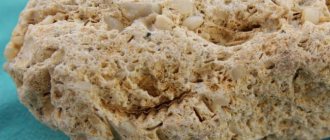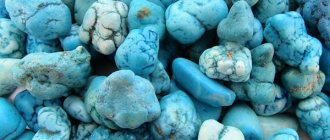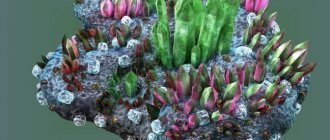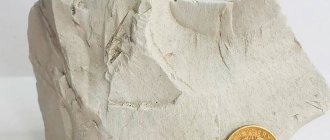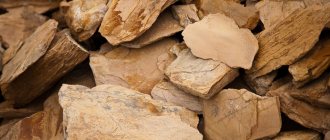Everyone is familiar with limestone: both pliable chalk and durable marble are essentially it. The mineral is unprepossessing in appearance, not rare in nature, and not difficult to process.
And with all this, he managed to become famous in culture and history: ancient Egyptian pyramids, majestic temples and cathedrals, the famous Wall of China, the Moscow Kremlin and other masterpiece buildings were created from it.
There are many signs associated with it; truly miraculous properties are attributed to it. The origin of natural limestone, its varieties, and various uses will be discussed further.
Limestone: origin of the rock
Limestone rock
Natural stone limestone is a non-solid sedimentary rock with a maximum content of calcite. The rest of the mineral mass consists of inclusions of particles of other substances (silicon, phosphates, quartz, lime, etc.).
Microparticles of the skeletons of simple organisms can also be found in the mass of calcium carbonate. The origin is generally characterized as organic, but there is also an organo-chemical path to the formation of the mineral.
The limestone mineral is mainly formed in the shallow water environment of the sea basin. Freshwater conditions also allow limestone to be deposited. Its usual form of occurrence is a layer.
It can be deposited according to the principle of salt: during the evaporation of water from lakes and lagoons. But the bulk of the stone originated precisely in the depths of the sea, where there were no intense processes of evaporation and drying.
The natural mechanism of mineral formation begins with the work of living organisms. They extract calcite from seawater and build shells. Then the remains of their skeletons accumulate on the bottom surface in a huge mass.
The most significant example of the formation of calcite carbonate is the birth, growth and death of coral reefs. It is not uncommon for piece shells to be found on a fracture in a calcareous rock. This variety is called shell rock.
Other species are also named according to the types of organisms and their metabolic products:
- nummulitic limestone;
- bryozoan limestone;
- oolitic limestone.
Marble-like limestone is a separate category. It, in turn, is divided into massively layered and thin-layered types.
Under the influence of certain temperatures and pressure, it changes the structure of the crystals and is transformed into marble.
Limestone in construction
The construction industry is the main consumer of the mineral we are considering. Dolomitized (rock) limestone is used for the production of putty and plaster mixtures, sealants and other things. White limestone is used in huge quantities in the finishing and decoration of buildings. Shell rock is often found as building blocks, etc. We will not focus on this industry, it is already widely known to everyone. So let's move on.
Limestone mineral: properties, formula and description
Natural stone limestone photo
As already said, the lion's share of the mineral's composition is calcium carbonate. The chemical formula of limestone is CaCO3. The properties of this compound allow it to dissolve in water. In nature, this process has global significance: in this way, limestone becomes an important participant in the formation of karst forms of underground relief. Under some conditions, CaCO3 also decomposes into a number of bases, where the most voluminous is carbon dioxide. This reaction also plays a global role in natural life - natural carbonation of mineral waters occurs.
The mineral varieties are characterized by color as follows:
- Traditional colors are light gray, white or cream.
- Colors - pinkish, yellowish, reddish, blue and black.
There is no shine as a specific feature. Density: - /+ 2.6 points. Frost resistance and high thermal insulation.
When the rock is fired, quicklime is formed - one of the oldest building materials.
And when it is dissolved in acetic compounds, an aggressive reaction is obtained with hissing, bubbling and complete dissolution of the mineral.
This, by the way, is the surest way to distinguish natural stone from fake.
Technical Parameters of Limestone
Dolomites and limestones containing magnesium carbonate have greater hardness. They are more difficult to mechanically influence.
Natural limestone is durable and hard. When crushed, it forms an uneven fracture. Doesn't get wet in water. The physical properties of the rock allow it to be used in construction.
Usually the carbonate compound is white, gray in color. But depending on the presence of impurities, the external color and technical characteristics of limestone change. The minerals contained in the formation not only change color, but also affect strength, stability and determine the scope of application.
The carbonaceous substance colors the rock black, the yellow color is determined by the presence of iron hydroxides, and the greenish color is determined by glauconite.
A description of the technical parameters of the material is contained in the deposit passport. The information collected in the document fully reflects the properties of the breed and its compliance with state standards regulated by law.
The structure of limestone allows us to distinguish types of rock. The texture of the mineral formation is uniform, sometimes there are pores and cavities (voids).
Classification by breed color
Calcium carbonate in its pure form is a white powder; the color of limestone stone depends only on impurities, therefore, it can be used to determine what limestone consists of and what is included in its composition, except calcite. And by the intensity of the color one can judge the amount of impurities. Various shades of the mineral are given by:
- Manganese, which colors the mineral red or brown.
- Iron - giving it a yellow or brown tint.
- Fossilized seaweed is the reason for the greenish color of limestone.
- Occasional inclusions of organic matter will make the stone black or dark gray.
A white or light gray color indicates that the mineral either does not contain impurities or their amount is negligible.
Separation according to the structural features of the mineral
The type and amount of impurities determines what limestone looks like, what its structure is, as well as the physical and chemical properties of the stone. In particular, such a parameter as the solubility of the stone under the influence of water and carbonic acid is important, since it determines the ability to resist corrosion. Based on density, solubility and structural characteristics, rocks are distinguished:
- Dolomite - containing magnesium oxide and being a transitional form between limestone and dolomite. Dolomite limestone is characterized by pronounced layering, it is less soluble than other types of mineral, and therefore is less susceptible to corrosion.
- Marble - with a high percentage of carbonate and organic matter. They have high strength, resistance to aggressive factors and a dense fine-grained structure. They are similar in appearance and properties to marble, but are softer because they have not undergone the crystallization process.
- Coral is a porous, easily destroyed rock.
- Clay - soft, friable and brittle, susceptible to corrosion.
Limestone stone deposits
Some mountain ranges are entirely composed of this mineral. The breed is widespread in the Alps and Crimea.
Of the continents, North America is also rich in stone, but Australia is lagging behind in this sense: its constituent rocks do not contain calcite.
The most fertile deposits are concentrated in the Caucasus, the Siberian region, and the Urals. China is an important supplier of a type of construction mineral – marl.
The Zhdanovskoye deposit, which was developed on the territory of the Russian Federation in the Orenburg region, is recognized as a very promising modern source of limestone.
What are formations characterized by?
Among carbonate deposits, the following types of limestone are distinguished:
- dense carbonates (characterized by a homogeneous structure);
- oolitic formations of spherical shape;
- tuffs are formations with large pores, which are durable and easy to process (polished, grinded);
- travertine – sinter formations;
- clayey and bituminous limestones.
The coral limestone in the sediments is supplemented with an admixture of foraminiferal shells and mollusks, and echinoderm shells. The rock that makes up modern reefs has a hard, porous structure and consists of the skeletons of colonies of polyps.
Putilov limestone is known as the main building material used during the construction of the city of St. Petersburg. The name of the rock is associated with the Putilov deposit located nearby.
The density of limestone is average, it does not collapse under the influence of shock loads, and is resistant to abrasion, aggressive acidic environments and salts. It contains small voids formed as a result of rock leaching.
The color of limestone is gray, alternating with dark gray. The crystalline mineral formation of organogenic origin contains dolomite (2-25%), glauconite grains (up to 20%), phosphates (2-3%), grains of silicate compounds (quartz).
Due to its external similarity, limestone is often mistaken for marble. The difference between breeds lies in the form of their formation. For example, the black Portoro marble from which sculptures are created is a sedimentary rock. The structure of limestone is different from marble.
The formation of marble occurs through the process of metamorphic changes and recrystallization of rock. It contains no traces of fossils.
If the conversion process is not completed, the result is marbled limestone. It is this rock that contains white calcite inclusions of bioherms (corals), shells, and fragments of skeletons of other marine inhabitants.
The petrographic and mineralogical definition of the rock is “marble-like limestone.” In the literature on engineering geology, in the section devoted to the classification of rock types, incompletely transformed limestone is called marble.
Dolomitized limestone is a gray and dark gray sedimentary rock composed of calcite and dolomite. The mineral composition of the formations is formed by inclusions of gypsum, anhydrite and silicon, feldspars, pyrite, clayey matter and flora relics (blue algae).
The strength of limestone, which includes magnesium carbonate (about 40%), during compression is 400-1300 kgf/cm², the hardness of dolomite on the Mohs scale is 3.5-4.5.
Applications of limestone stone
Processed limestone stone
Over the entire period of its existence, people have deeply understood the properties of this natural gift and learned to use it with maximum benefit.
Here are the main areas of human activity where limestone is an important material:
- Construction. Varieties of stone are useful here in everything: in the construction of stable high-rise buildings, in cladding facades and for paving surfaces.
- Landscape design and architecture. Ease of processing and decorative properties are highly valued in these areas, especially when it comes to layered types of mineral with a characteristic weathering pattern.
- Production of finishing materials. Here the emphasis is not on decorativeness, but on the organic origin of the stone.
- Cretaceous rocks are used to make crayons, tooth powders, and the production of expensive high-quality paper.
- Cable production cannot proceed without coating welding electrodes with limestone compounds.
- The printing industry widely uses lithographic limestone to create highly artistic engravings.
- Jewelry making. Translucent samples of pastel colors are appreciated. The best design and decorative combinations are obtained with silver and cupronickel frames.
Where is limestone used?
Recently, this material is often used in construction and cladding. They are used to decorate walls, floors, stairs, cornices, railings, baseboards and arches. Some types of limestone are used as a decorative material. It is often used in the construction of roads and embankments. Dolomitic limestone has found application in the manufacture of building mixtures. Some varieties of this rock are used to produce cement and lime.
Limestone rock is used for paving paths and creating floor coverings. Limestone floor tiles are very popular these days. It is made like a mosaic. It is well suited for the kitchen, hallway, bathroom, hallway. Such tiles will cost significantly less than marble ones, but in appearance and some other qualities they are not inferior to them.
In garden and summer cottage plots, limestone is used to lay out garden paths, the bottoms of reservoirs, and fountains; it is used in the construction of fences, design of flower beds and public gardens. A layer of limestone fragments retains moisture well, and in heavy rain helps absorb it into the soil.
Limestone paths
In artistic creativity, this stone is of great importance when creating sculptures. It is used as a filter material in water filters.
In industry, this material is a raw material in the production of paints and varnishes, plastics and rubber. It is used as a source of calcium in the glass production process chain. White paint for paper also cannot do without products obtained from this material. Such seemingly different products as wall and floor tiles, tiles, pipes, linoleum also include limestone in their composition.
In the chemical industry it is needed in the production of toothpastes, shoe polish, and cleaning products.
Limestone stone: beneficial properties
Lithotherapists, basing their recommendations on the experience of many generations, advise using the mineral as a remedy with the following qualities:
- absorbent;
- hypoallergenic;
- antiseptic.
For any illness, it is considered beneficial to drink water that has been purified with calcite.
It is also believed that limestone stones purify and disinfect indoor air.
Limestone can only cause harm to those who mine it - inhaling mineral dust and its settling in the lungs does not have the best effect on health.
There is a whole gradation of the healing properties of limestone based on color:
- Reddish calcite. Treats nervous feelings and blood diseases.
- Yellowish limestone. For meditation and regulation of digestion.
- Pink varieties. Nervous disorders, healthy sleep.
- Blue limestone. Reduced pressure.
The therapeutic effect is achieved through contact with the stone: it is applied to the diseased area.
You can simply hold it in your hands during individual attacks and manifestations of the disease.
Limestone stone: magical properties and zodiac signs
In magic, a legend is associated with the stone that it develops the extrasensory abilities of every person and opens the way to clairvoyance.
This is a talisman against laziness and for creative imagination. Astrologers have included limestone in the list of universal stones suitable for most zodiac signs.
Only Scorpios are excluded - among them there are most people prone to the occult and black magic. And limestone, in its aura, is a conductor of light energy and high spiritual vibrations. This contradicts the mystical bias of Scorpios, and the limestone talisman is “not friendly” with the strong-willed and aggressive sign.
As for the rest, the mineral willingly shares its invigorating and inspiring properties and helps the owner see the outcome of the situation.

